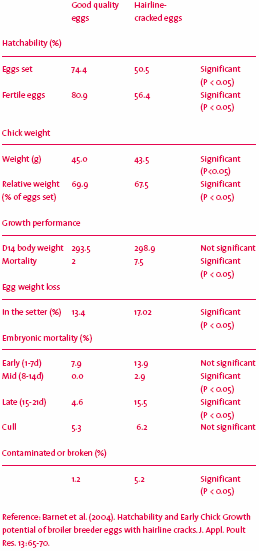



Do hairline-cracked eggs influence hatchability and chick performance?
By Pas-Reform - In general, good quality eggs are selected and placed for incubation. This means that only clean eggs with shell intact should be placed on the setter trays.
Background
Dirty or floor eggs and
eggs with visible cracks are removed and not placed. Eggs
with hairline cracks might often not be recognised and will,
consequently, be placed in the setter trays and incubated.
 In cracked eggs, the shell is broken and the underlying
membrane is ruptured - leading to dehydration and the
death of the embryo. However eggs with undamaged
membranes but broken shells are defined as having hairline
cracks - and these are often placed because unless candled,
they look like good quality eggs.
In cracked eggs, the shell is broken and the underlying
membrane is ruptured - leading to dehydration and the
death of the embryo. However eggs with undamaged
membranes but broken shells are defined as having hairline
cracks - and these are often placed because unless candled,
they look like good quality eggs.
A research group from the University of Alberta has recently
analysed the weight loss, embryonic mortality and
hatchability of eggs with hairline cracks, with the following
findings:
Eggs from five commercial flocks of various strains were
candled and an equal number of hairline-cracked and
normal eggs were incubated for 21 days. Eggs were identified
as having a hairline crack if the crack was visible by candling,
but not apparent when examined normally. The results are
summarised in the table.
Conclusions
Setting eggs with hairline-cracks significantly reduces hatchability.
Chicks hatched from hairline-cracked eggs show a higher incidence of mortality during a 14 day growing period.
Egg weight loss during the setting period increases significantly in hairline-cracked eggs; consequently chicks hatched from hairline-cracked eggs are smaller. This, however, had no effect on day 14 weight.
Compared to good quality eggs, a significantly higher incidence of contaminated and broken eggs was found after incubation of hairline-cracked eggs.
Advice
Hairline-cracked eggs should not be incubated.
candle egg samples from batches transported to the hatchery on a regular basis.
Register the number of eggs with hairline-cracks on Pas Reform’s Hatchery Recording Form no. 2C (to receive your free copy of Pas Reform’s Hatchery Recording Forms, please complete and return the order form in the Library document Incubation Guide on www.pasreform.com).
If the frequency of hairline-cracked eggs is unsatisfactory, investigate and eliminate possible causes.
Try to avoid the use of plastic trays with sharp edges for the transportation of eggs, as these are likely to be a major cause of hairline-cracks.








